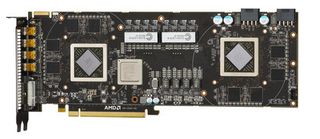Why you can trust TechRadar
Architecture

As I've already mentioned the AMD Radeon HD 6990 is based on the latest and greatest DirectX 11 GPUs AMD is currently producing, the Cayman XT. That GPU is the one powering the AMD Radeon HD 6970, and with a little software modification in the AMD Radeon HD 6950 too.
There has been a certain amount of modification done to those Cayman GPUs though to squeeze them into the multi-GPU format which we'll come to later. This slightly modified GPU then is codenamed Antilles.
GPU-aside though you're looking at almost exactly double the componentry used on a single Radeon HD 6970. Therefore we've got a full 4GB of GDDR5 graphics memory, the same 256-bit memory bus and one hell of a power draw to boot.
From scratch the Radeon HD 6990 has been devised and designed as a 450w graphics card.
Now before you start getting all defensive over those PCIe power limitations it's time to start explaining exactly what AMD has done to those Cayman GPUs to magically transform them into Antilles chips.
On one hand it's done nothing, but on the other BIOS setting things have changed.
Yup, the Radeon HD 6990 has the dual-BIOS functionality that came with both the Radeon HD 6970 and HD 6950. This time around though it's being used to keep to the power restrictions set by the PCIe bus.
The primary positioning, the default setting you'll see retail cards set at out of the box, restricts the Antilles GPUs to 830MHz core speeds.
That's only slightly quicker that the cores of the Radeon HD 6950 at 800MHz.
As well as limiting the core speed that restriction also means the power draw is limited to 375w, the theoretical maximum power draw possible with a single card. Each of the two 8-pin PCIe power connectors the Radeon HD 6990 needs to run delivers 150w per plug and the PCIe slot itself is capable of delivering another 75w itself.
This adds up to the 375w total.
That primary BIOS setting is read-only, but the second chip is able to be flashed with a new ROM should you wish. At launch the switch will be covered with a warning sticker and you'll have to accept all responsibility for anything that occurs under the second BIOS setting.
Why so serious?
Well, this is what we mean by the card being designed for 450w. Having the GPUs running at the 880MHz core speed the Radeon HD 6970 has its chips running at means the HD 6990 draws a significant amount of power outside the standard PCIe limits.
And you're going to need to make sure you've got a hefty PSU, and one that delivers a solid, stable level of juice to the motherboard and card to enable it to run happily at that overcooked speed.
AMD is likening this dual-BIOS, Antilles Unlocking Switch to its Overdrive software in the Catalyst Control Centre, calling it a 'hardware Overdrive option.'
Previous dual-GPU cards from AMD have used slightly clocked-down GPUs to maintain stable performance, and this is the first time we've seen the full-fat cores enabled on such a beast.
The Radeon HD 5970 used cores that were slightly quicker than the Radeon HD 5850, but couldn't hit the speeds the Radeon HD 5870s managed.
But the HD 6990 still has the same mammoth footprint of the HD 5970, though the layout is markedly different. Instead of having the fan at the end of the card it is now sat directly between the two GPUs.
This ensures both chips get equal amounts of cooling, unlike the previous generations where one was cooled more than the other. This symmetrical layout also reportedly allows for more efficient power flow as the voltage regulators are situated equidistant between the GPUs.
Each chip also has its own vapor-chamber heatsink attached to it via a phase-change thermal interface material. So take care dismantling it…
Big, hot and heavy then, so how does it perform?
Current page: AMD Radeon HD 6990: Architecture
Prev Page AMD Radeon HD 6990: Overview Next Page AMD Radeon HD 6990: Benchmarks
I'm off to France this summer, and this app could make me très fluent

Intel unveils flurry of new Arc GPUs — however serious graphics users will have to wait for more powerful models, as these focus on a completely different and more lucrative market

We just got another hint that the Samsung Galaxy Watch 7 is almost here